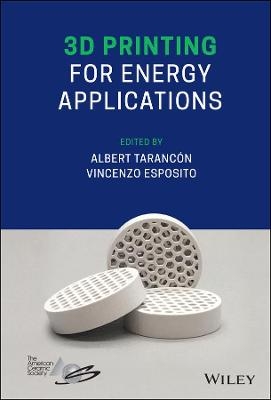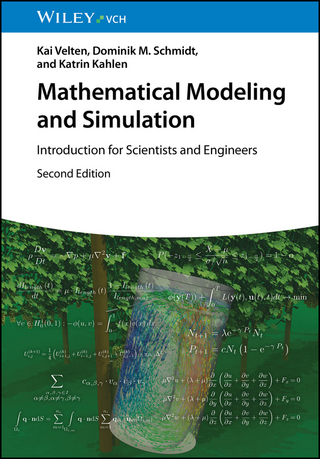
3D Printing for Energy Applications
Wiley-American Ceramic Society (Verlag)
978-1-119-56075-3 (ISBN)
3D Printing for Energy Applications delivers an insightful and cutting-edge exploration of the applications of 3D printing to the fabrication of complex devices in the energy sector. The book covers aspects related to additive manufacturing of functional materials with applicability in the energy sector. It reviews both the technology of printable materials and 3D printing strategies itself, and its use in energy devices or systems.
Split into three sections, the book covers the 3D printing of functional materials before delving into the 3D printing of energy devices. It closes with printing challenges in the production of complex objects. It also presents an interesting perspective on the future of 3D printing of complex devices.
Readers will also benefit from the inclusion of:
A thorough introduction to 3D printing of functional materials, including metals, ceramics, and composites
An exploration of 3D printing challenges for production of complex objects, including computational design, multimaterials, tailoring AM components, and volumetric additive manufacturing
Practical discussions of 3D printing of energy devices, including batteries, supercaps, solar panels, fuel cells, turbomachinery, thermoelectrics, and CCUS
Perfect for materials scientists, 3D Printing for Energy Applications will also earn a place in the libraries of graduate students in engineering, chemistry, and material sciences seeking a one-stop reference for current and future perspectives on 3D printing of high value-added complex devices.
Albert Tarancón is ICREA Research Professor and Head of the Nanoionics and Fuel Cells Group at the Catalonia Institute for Energy Research. He has authored over 100 peer-reviewed articles, 5 book chapters, and given over 200 oral presentations. He is Editor of the Journal of Physics Energy and the Journal of the European Ceramic Society. Vincenzo Esposito is Professor and Technology Coordinator in Ceramic Science and Engineering at the Department of Energy Conversion and Storage, Technical University of Denmark. His research focus is at the intersection of nanoionics, solid state chemistry and advanced materials processing.
Contributor xiv
Introduction to 3D Printing Technologies xviii
Part I 3D printing of functional materials 1
1 Additive Manufacturing of Functional Metals 3
Venkata Karthik Nadimpalli and David Bue Pedersen
1.1 Introduction 3
1.1.1 Industrial Application of Metal AM in the Energy Sector 5
1.1.2 Geometrical Gradients in AM 6
1.1.3 Material Gradients in AM 6
1.2 Powder Bed Fusion AM 7
1.2.1 Geometric Gradients in PBF 8
1.2.2 Material Gradients in PBF 9
1.3 Direct Material Deposition 12
1.3.1 Powder and Wire Feedstock for Near-Net-Shape AM 12
1.3.2 Functional Material Gradients in DED 13
1.4 Solid-State Additive Manufacturing 16
1.5 Hybrid AM Through Green Body Sintering 19
1.5.1 Common AM Technologies for Green Body Manufacturing 19
1.5.2 CAD Design and Shrinkage Compensation 20
1.5.3 Additive Manufacture 20
1.5.4 Debinding and Sintering 21
1.5.5 Functionally Graded Components in Sintered Components 22
1.6 Conclusions 22
Acknowledgment 24
References 24
2 Additive Manufacturing of Functional Ceramics 33
José Fernando Valera-Jiménez, Juan Ramón Marín-Rueda, Juan Carlos Pérez-Flores, Miguel Castro-García, and Jesús Canales-Vázquez
2.1 Introduction 33
2.1.1 Why 3D Printing of Technical Ceramics? 35
2.1.2 Materials and Applications 35
2.2 Ceramics 3D Printing Technologies 36
2.2.1 Lamination Object Modeling (LOM) 37
2.2.2 Ceramics Extrusion 38
2.2.2.1 Robocasting/Direct Ink Writing 39
2.2.2.2 Fused Deposition of Ceramics 42
2.2.3 Photopolymerization 44
2.2.4 Laser-Based Technologies 47
2.2.5 Jetting 49
References 52
3 3D Printing of Functional Composites with Strain Sensing and Self-Heating Capabilities 69
Xin Wang and Jihua Gou
3.1 Introduction 69
3.2 Carbon Nanotube Reinforced Functional Polymer Nanocomposites 70
3.2.1 Strain Sensing of CNT Reinforced Polymer Nanocomposites 70
3.2.2 Resistive Heating of CNT Reinforced Polymer Nanocomposites 71
3.3 Printing Strategies 72
3.3.1 Spray Deposition Modeling and Fused Deposition Modeling 72
3.3.2 Printing of Highly Flexible Carbon Nanotube/Polydimethylsilicone Strain Sensor 73
3.3.3 Printing of Carbon Nanotube/Shape Memory Polymer Nanocomposites 73
3.4 Strain Sensing of Printed Nanocomposites 73
3.5 Electric Heating Performance Analysis 79
3.6 Electrical Actuation of the CNT/SMP Nanocomposites 82
3.7 Conclusions 85
References 87
Part II 3D printing challenges for production of complex objects 91
4 Computational Design of Complex 3D Printed Objects 93
Emiel van de Ven, Can Ayas, and Matthijs Langelaar
4.1 Introduction 93
4.2 Dedicated Computational Design for 3D Printing 95
4.2.1 Overhang Angle Control Approaches 96
4.2.1.1 Local Angle Control 96
4.2.1.2 Physics-Based Constraints 97
4.2.1.3 Simplified Printing Process 97
4.2.2 Design Scenarios 98
4.3 Case Study: Computational Design of a 3D-Printed Flow Manifold 99
4.3.1 Fluid Flow TO 100
4.3.2 Front Propagation-Based 3D Printing Constraint 102
4.3.3 Fluid TO with 3D Printing Constraint 103
4.4 Current State and Future Challenges 104
References 105
5 Multicomponent and Multimaterials Printing: A Case Study of Embedded Ceramic Sensors in Metallic Pipes 109
Cesar A. Terrazas, Mohammad S. Hossain, Yirong Lin, and Ryan B. Wicker
5.1 Multicomponent Printing: A Short Review 109
5.2 Multicomponent Printing: A Case Study on Piezoceramic Sensors in Smart Pipes 111
5.2.1 Brief Introduction to AM of Embedded Sensors for Smart Metering 111
5.2.2 Fabrication of the Embedded Piezoceramic Sensor in Metallic Pipes 114
5.2.2.1 Smart Coupling Fabrication Process Using EPBF Technology 114
5.2.2.2 Materials 116
5.2.2.3 Sensor Housing 117
5.2.2.4 Re-poling of PZT 118
5.2.2.5 Impact in Sensing Properties Due to Heat-Treatment Induced By AM Process 119
5.2.2.6 Smart Coupling Component 119
5.2.2.7 Compressive Force Sensing 119
5.2.2.8 Temperature Sensing 120
5.2.3 Impact of the AM and Performance of the Multicomponent Printed Device 122
5.2.3.1 Compressive Force Sensing 122
5.2.3.2 Temperature Sensing 124
5.2.3.3 Crystalline Structure Analysis 126
5.3 Summary and Outlook 128
Acknowledgments 129
References 130
6 Tailoring of AM Component Properties via Laser Powder Bed Fusion 135
Simon Ewald, Maximilian Voshage, Steffen Hermsen, Max Schaukellis,
Patrick Köhnen, Christian Haase, and Johannes Henrich Schleifenbaum
6.1 Introduction 135
6.2 Machines, Materials, and Sample Preparation 138
6.3 Sample Preparation and Characterization Techniques 139
6.4 Material Qualification and Process Development 140
6.5 Tailoring Grain Size via Adaptive Processing Strategies 143
6.6 Tailoring Material Properties By Using Powder Blends 146
6.7 Tailoring Properties By Using Special Geometries Such As Lattice Structures 148
Funding 150
Conflicts of Interest 150
References 150
7 3D Printing Challenges and New Concepts for Production of Complex Objects 153
Hayden Taylor, Hossein Heidari, Chi Chung Li, Joseph Toombs, and Sui Man Luk
7.1 Introduction 153
7.2 Geometrical Complexity 154
7.3 Material Complexity 155
7.4 Energy Requirements 156
7.5 Promising Metal Deposition Approaches 157
7.6 Multimaterial and Multi-property SLA 159
7.7 Temporal Multiplexing 159
7.8 Resin Formulations with Multiple End-States 160
7.9 Associated Processing Considerations 160
7.10 Bioprinting of Realistic and Vascularized Tissue 162
7.11 Emerging Volumetric Additive Processes 163
7.12 Computation for CAL 166
7.13 Material–Process Interactions in CAL 167
7.14 Current Challenges in CAL 169
7.15 Expanding the Capabilities of CAL 170
7.16 Concluding Remarks and Outlook 171
Acknowledgments 172
References 172
Part III 3D printing of energy devices 181
8 Current State of 3D Printing Technologies and Materials 183
Poul Norby
8.1 3D Printing of Energy Devices 183
8.1.1 Batteries 183
8.1.1.1 3D Printing Structured Electrodes 186
8.1.1.2 3D Printing Solid Electrolytes 195
8.1.1.3 3D Printed Full Batteries 197
8.1.1.4 Conclusion and Outlook 200
References 200
9 Capacitors 205
Lukas Fieber and Patrick S. Grant
9.1 Introduction 205
9.2 Capacitors and Their Current Manufacture 206
9.2.1 Capacitor Classifications, Operating Principles, Applications, and Current Manufacture 206
9.2.1.1 Electrostatic Capacitors 206
9.2.1.2 Electrolytic Capacitors 209
9.2.1.3 Electrochemical Capacitors 210
9.2.2 Capacitor Components: Function and Requirements 211
9.2.3 Performance 213
9.2.4 The Challenge of Manufacturing Capacitors 214
9.3 The Promise of Additive Manufacturing 215
9.4 Additive Manufacturing Technologies: Considerations for Capacitor Fabrication 217
9.4.1 AM Process Categories 217
9.4.1.1 Material Extrusion – Fused Filament Fabrication 217
9.4.1.2 Material Extrusion – Direct Ink Writing 221
9.4.1.3 Vat Polymerization 223
9.4.1.4 Powder Bed Fusion 225
9.4.1.5 Material Jetting 227
9.4.1.6 Binder Jetting 228
9.4.2 Multi-technology or Hybrid Printing 229
9.4.3 Complete Capacitor Devices Fabricated by Additive Manufacturing 230
9.5 Summary and Outlook 232
Acronyms 233
References 235
10 3D-Printing for Solar Cells 249
Marcel Di Vece, Lourens van Dijk, and Ruud E.I. Schropp
10.1 Introduction 249
10.2 Examples of 3D-Printing for PV 250
10.3 Geometric Light Management 255
10.3.1 Background 255
10.3.2 Optical Model for External Light Trapping 257
10.3.3 Design and 3D-Printing of the External Light Trap 260
10.3.4 Characterization 261
10.4 Conclusions 266
References 267
11 3D Printing of Fuel Cells and Electrolyzers 273
A. Hornés, A. Pesce, L. Hernández‐Afonso, A. Morata, M. Torrell, and Albert Tarancón
11.1 Introduction 273
11.2 3D Printing of Solid Oxide Cells Technology 274
11.2.1 Solid Oxide Fuel Cells 275
11.2.1.1 SOFC Electrolyte 276
11.2.1.2 SOFC Electrodes 278
11.2.2 Solid Oxide Electrolysis Cells 283
11.2.3 SOC Stacks and Components 284
11.3 3D Printing of Polymer Exchange Membranes Cells Technology 286
11.3.1 Polymeric Exchange Membrane Fuel Cells 287
11.3.1.1 PEMFC Electrolyte 288
11.3.1.2 PEMFC Catalysts Layer 288
11.3.1.3 PEMFC Gas Diffusion Layer 289
11.3.1.4 PEMFC Bipolar Plates and Flow Fields 290
11.3.2 Polymer Exchange Membrane Electrolysis Cells 293
11.3.2.1 PEMEC Liquid Gas Diffusion Layer 293
11.3.2.2 PEMEC Bipolar Plates and Flow Fields 293
11.3.2.3 Fully Printed PEMEC 294
11.4 3D Printing of Bio-Fuel Cells Technology 294
11.5 Conclusions and Outlook 297
References 297
12 DED for Repair and Manufacture of Turbomachinery Components 307
S. Linnenbrink, M. Alkhayat, N. Pirch, A. Gasser, and H. Schleifenbaum
12.1 Introduction 307
12.2 DED Based Repair of Turbomachinery Components 309
12.2.1 DED Process 310
12.2.2 Work Environment 310
12.2.3 Process Chain for the Repair of Turbine Blades 310
12.2.3.1 Step 1: “Machining & Preparation” 310
12.2.3.2 Step 2: “Reverse Engineering” 311
12.2.3.3 Step 3: “Generation of Tool Paths” 313
12.2.3.4 Step 4: “DED Process” 313
12.2.3.5 Step 5: “Adaptive Machining” 314
12.3 DED Based Hybrid Manufacturing of New Components 314
12.3.1 Hybrid Additive Manufacturing 315
12.3.2 Turbocharger Nozzle Ring 317
12.3.3 Hybrid Production Cell 319
12.3.4 Process Chain for Hybrid Additive Manufacturing of Nozzle Rings 320
12.3.4.1 Step 1: “Choice of DED Strategy” 320
12.3.4.2 Step 2: “DED Process” 321
12.3.4.3 Step 3: “Optical Metrology” 322
12.3.4.4 Step 4: “Adaptive Milling” 322
12.3.4.5 Step 5: “Joining of Top Ring” 322
12.4 Summary 323
Acknowledgments 324
References 324
13 Thermoelectrics 327
Fredrick Kim, Seungjun Choo, and Jae Sung Son
13.1 Introduction 327
13.2 Additive Manufacturing Techniques of Thermoelectric Materials 328
13.2.1 Extrusion-Based Additive Manufacturing Process 328
13.2.2 Fused Deposition Modeling (FDM) Technique 336
13.2.3 Stereolithography Apparatus (SLA) Process 337
13.2.4 Selective Laser Sintering (SLS) Process 339
13.2.5 Summary and Outlook 345
Acknowledgements 345
References 345
14 Carbon Capture, Usage, and Storage 351
Jason E. Bara
14.1 Introduction 351
14.2 Can 3D Printing Be Used to Fabricate a CO2 Capture Process at Scale? 354
14.3 A Brief Note on 3D Printing and CO2 at Smaller Scales & Research Efforts 356
14.4 Conclusions 358
References 358
Index 361
| Erscheinungsdatum | 09.06.2021 |
|---|---|
| Sprache | englisch |
| Maße | 10 x 10 mm |
| Gewicht | 454 g |
| Themenwelt | Naturwissenschaften ► Chemie |
| Technik ► Elektrotechnik / Energietechnik | |
| Technik ► Maschinenbau | |
| ISBN-10 | 1-119-56075-6 / 1119560756 |
| ISBN-13 | 978-1-119-56075-3 / 9781119560753 |
| Zustand | Neuware |
| Informationen gemäß Produktsicherheitsverordnung (GPSR) | |
| Haben Sie eine Frage zum Produkt? |
aus dem Bereich


